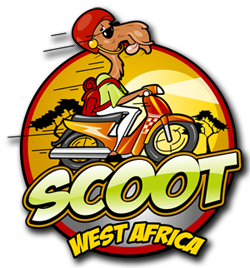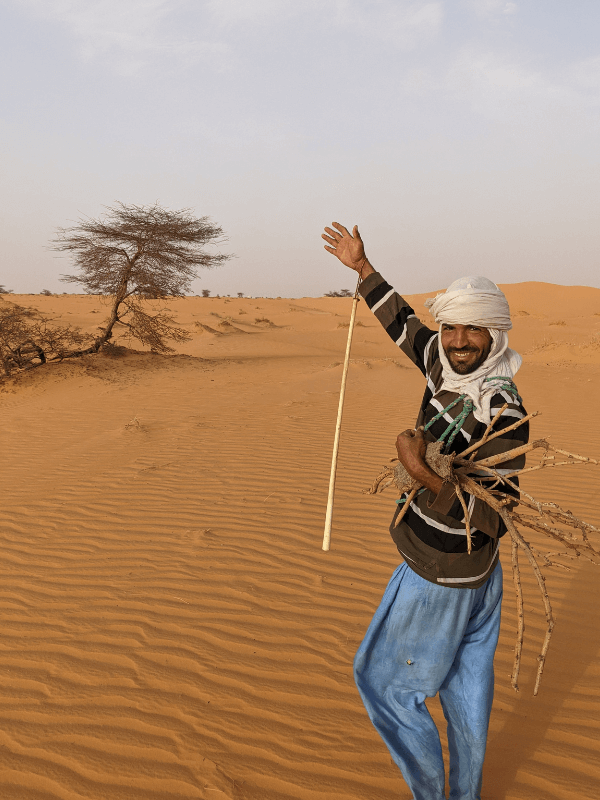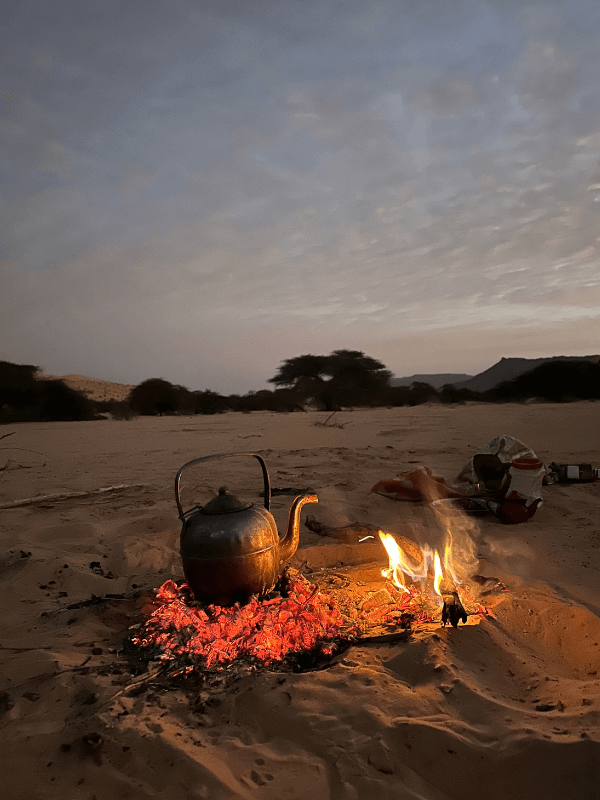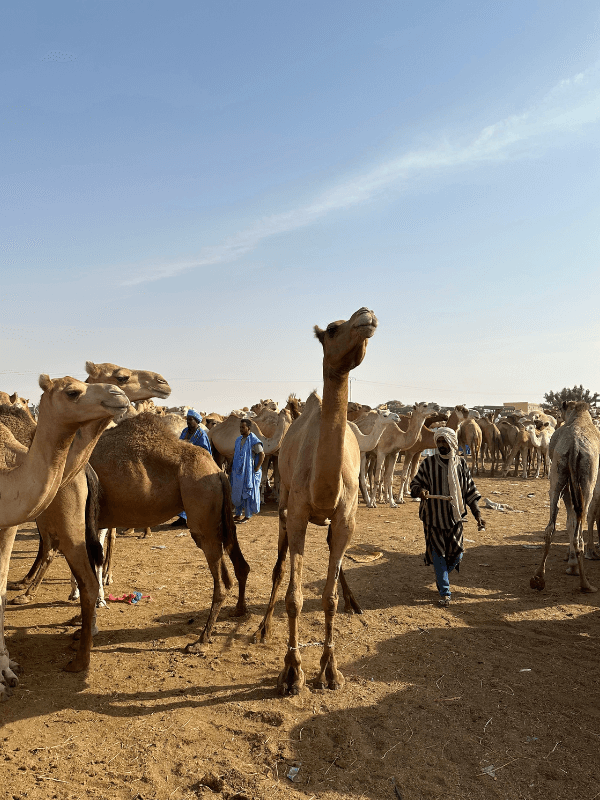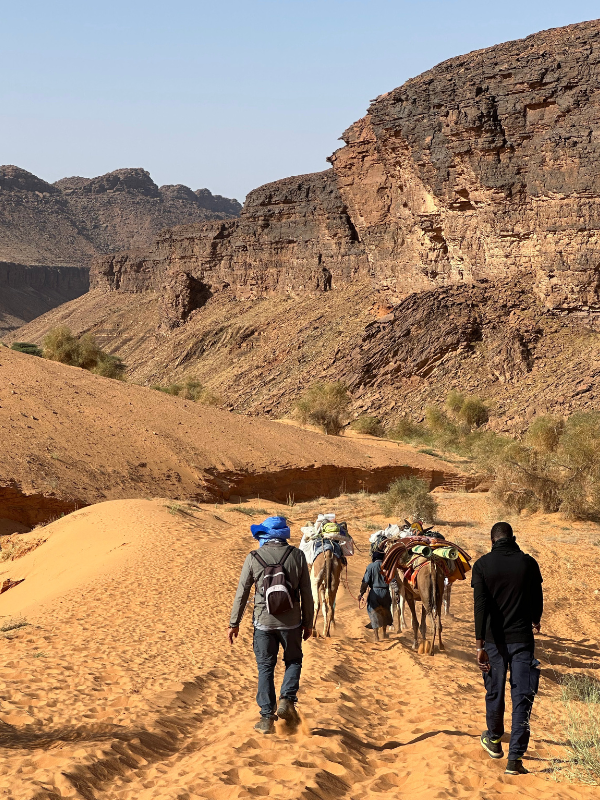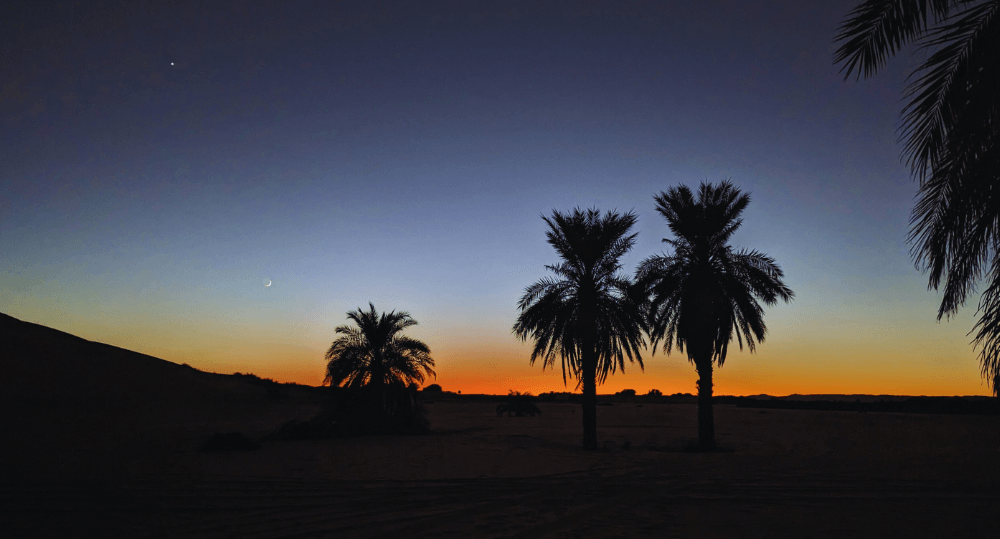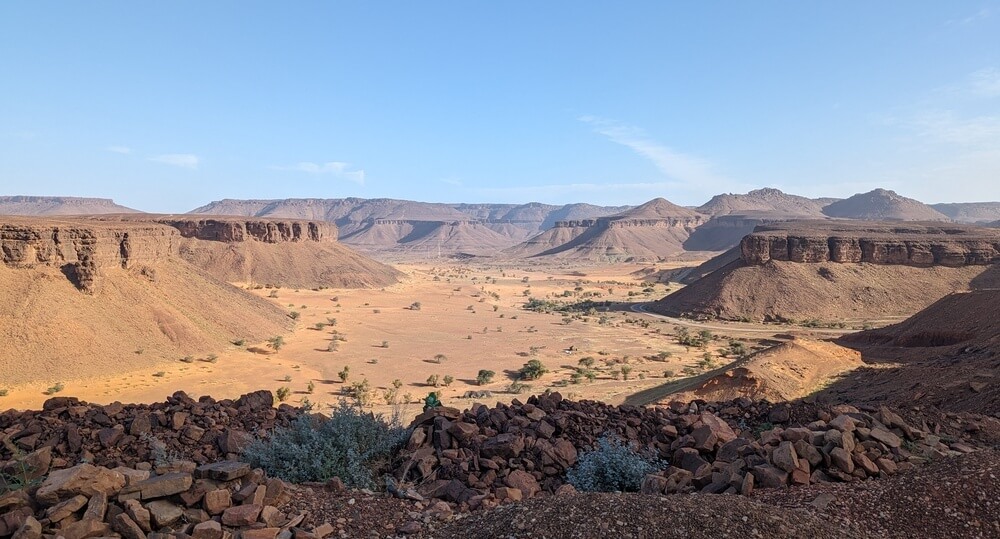
Where the Desert Meets the Sea: Mauritania
Mauritania is a land of contrasts, and in ten days we are going to squeeze a lot in. This tour is off the bikes to let us explore on foot and by car places that bikes can’t reach.
We’ll wander the streets of the ancient Saharan trading towns of Ouadane and Chinguetti, relax in lush oases, and spend a night with some nomads and their camels in the desert, falling asleep stargazing. We’ll swim in the Atlantic next to the towering dunes of the Banc d’Arguin National Park, and we’ll camp next to Africa’s largest monolith. We’ll bake bread under the Saharan sands, and we’ll learn to dance, Mauritanian style.
Itinerary
Please see our philosophy on itineraries. This itinerary is flexible and not necessarily chronological. Changes can be made depending on local conditions, spontaneous discoveries that can happen on the road, and the considerations of the group.
Day 1
We will leave Nouakchott in the morning and make our way to the Dune of Azouega. The landscape will quickly transform from seaside desert lite to full blown Sahara. We will get off the road to have a delicious local lunch before continuing on to the tallest dune in Mauritania. We will arrive before sunset and have time to hike up this golden, shimmering tower of sand for a panoramic view like few others. After dinner over the fire, we will camp at the bottom of the dune and fall asleep watching the stars.
Day 2
We will head further north and east to the western edge of the Adrar Plateau. Here we will find a gorge of palm groves surrounding a stream that bubbles up from a desert spring. This is the Terjit oasis. It is a magical spot where we can enjoy a swim in the natural spring while witnessing firsthand the importance of the oasis in Mauritanian nomadic life. We will stay at a locally run guesthouse as we prepare for our camel trek the following day.
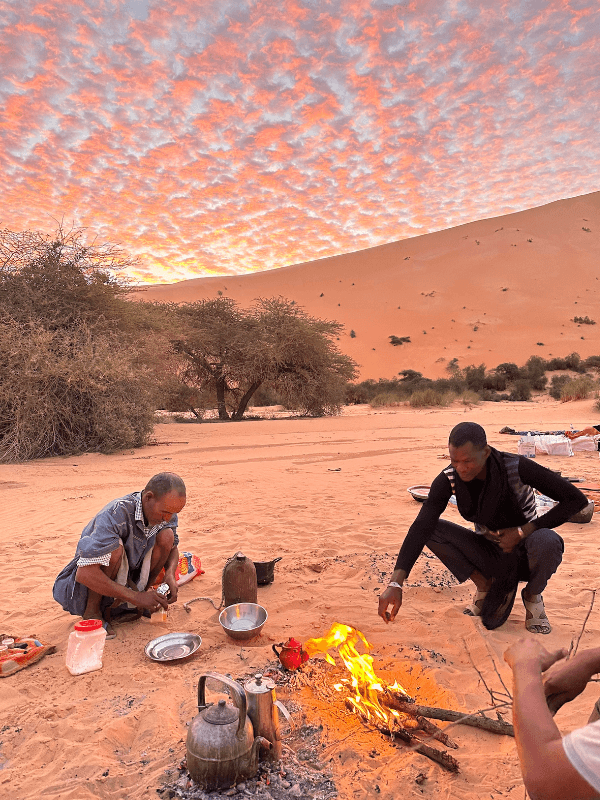
Desert Oases
A natural wonder and a lifeline for the local population
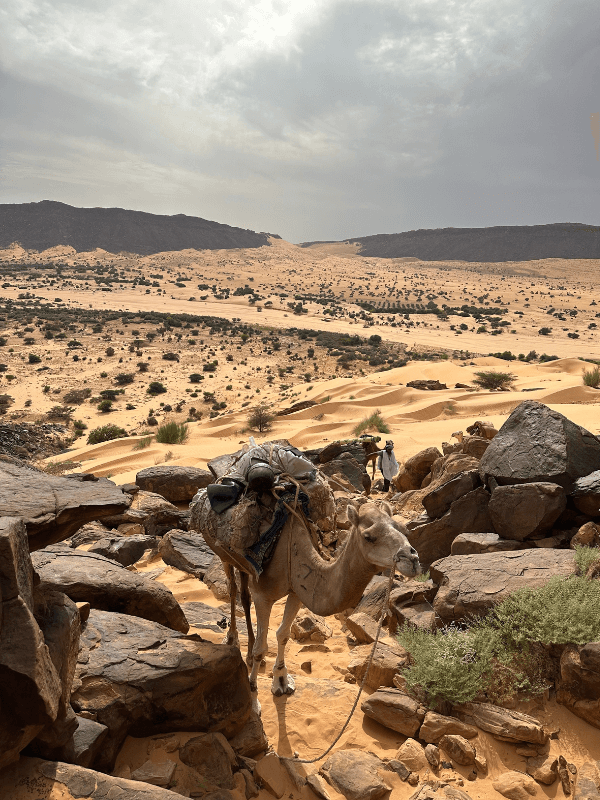
Camel Trek into the Desert
Day 3
We will meet up with our local guides in the morning as we prepare to walk into the heart of the Vallée Blanche (the White Valley), a strip of Saharan sand framed by dramatic cliffs and rock formations. Camels will carry all of our gear for us as we make our way to an open air camp site. We will prepare lunch and dinner together, make tea and even learn how to bake bread in the sand. Another night of falling sleep stargazing, this time truly off the grid, in the company of nomads and their camels.
Day 4
Sunrise at a desert camp in the Vallée Blanche of Mauritania is something you will not soon forget. We will eat breakfast and make tea with the remaining embers from the fire before continuing our walk towards Chinguetti, an ancient Saharan trading town that was founded in the 13th century. The dry-stone, mud-brick architecture and the sandy streets give the impression that the old town of Chinguetti is very much still in another century. Highlights are the Friday Mosque, topped with five ostrich egg finials, and the manuscript libraries. We will have the chance to explore both before spending the night in a local guesthouse.
A Window into Desert Life
Our overnight camel trek offers us a chance to see what life is like for Mauritanian nomads
Further into the Desert, Further into History
Day 5
We will continue our exploration of ancient Saharan trading towns as we drive a couple hours further into the Sahara, stopping at a desert oasis before arriving in the town of Ouadane. Like Chinguetti, the old quarter of Ouadane is a UNESCO World Heritage Site. We will dig into the town’s rich history before having a traditional meal for dinner and retiring to our local guesthouse.
Day 6
We will head back towards the Adrar plateau, eventually arriving at the regional capital of Atar. Once an important stop on the Paris Dakar Rally, the town of Atar remains the gateway to the north of the country. We will have lunch here at a local family home before we head back into the desert for a bivouac as we ready ourselves for a visit to Africa’s largest monolith, a stone’s throw from the border of Western Sahara and right next to the track that carries the iron ore train from Zouerat all the way to the coast.
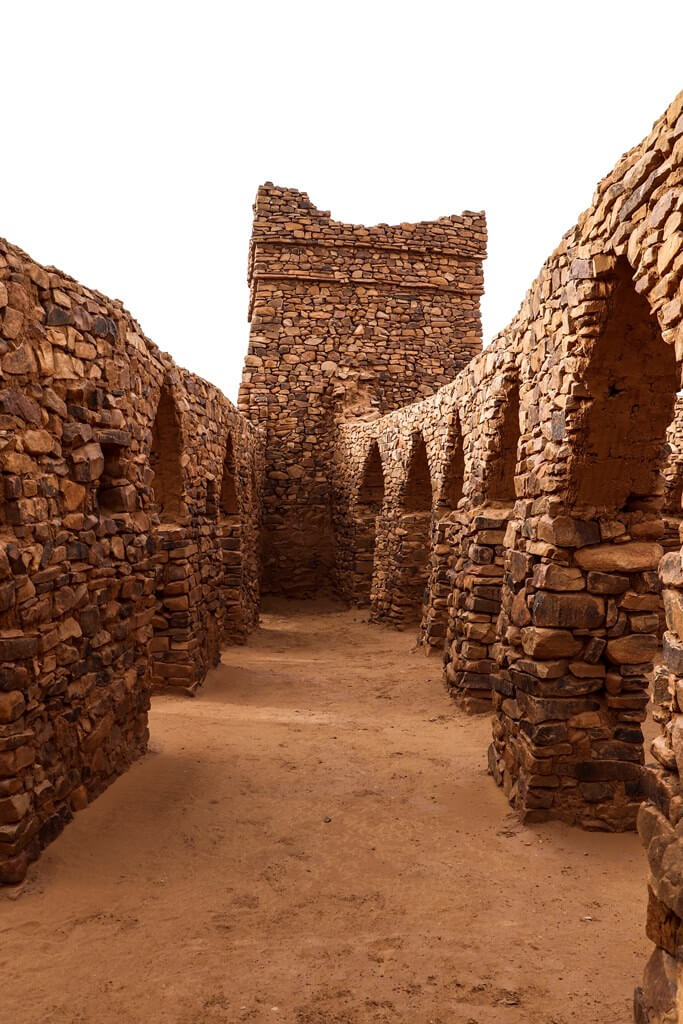
Final Adventures
Day 7
After a sunrise breakfast we will hit the road for Ben Amera, the largest monolith in Africa and the second largest in the world, only behind Uluru in Australia (some geologists actually think Ben Amera is bigger if you count the portion of rock that is beneath the surface of the sand!). Rising 633 meters above the desert floor, Ben Amera also lies a mere 4 kilometers from the track taken by the iron ore train between Zouerat and Nouadhibou. We will get to explore Ben Amera and its slightly smaller sister “Aisha” 20 kilometers away before camping next to this giant piece of rock in the desert.
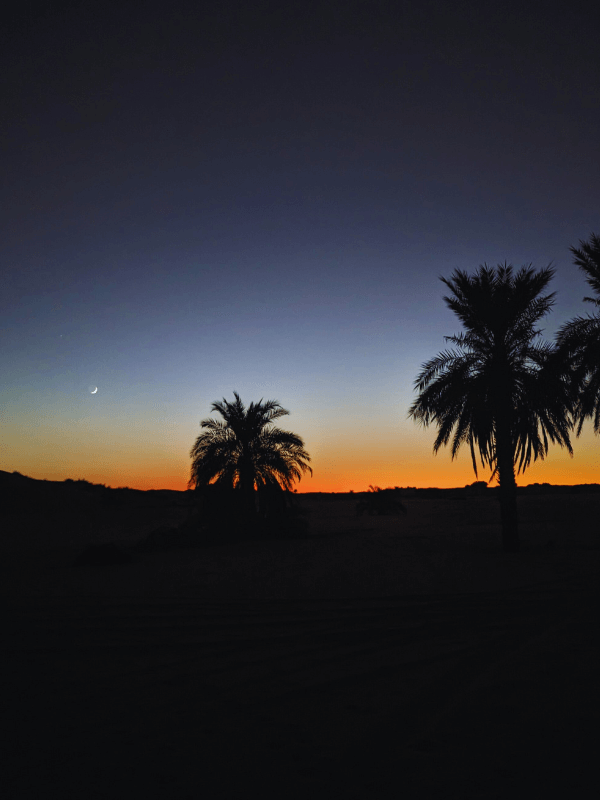
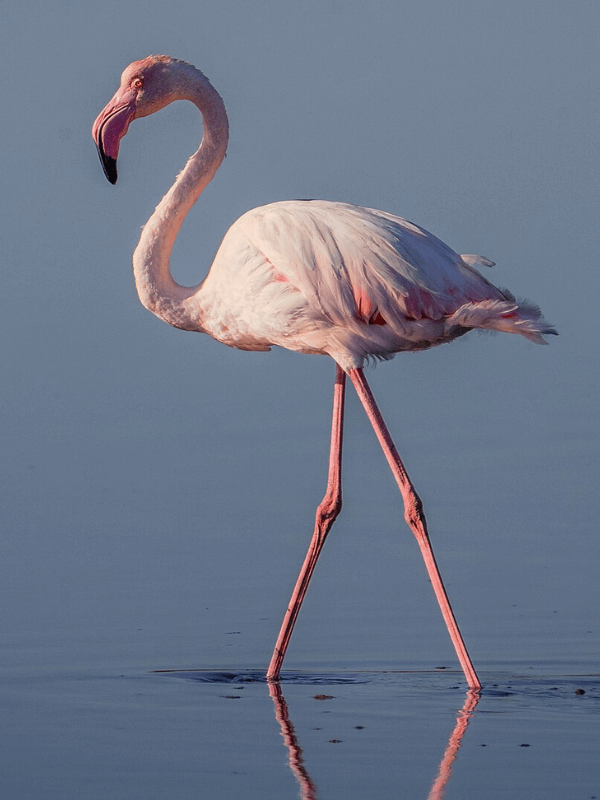
Down the Coast
Day 8
We will arrive in Nouadhibou in time for lunch. Mauritania’s second largest city is not quite cosmopolitan, but it is a fascinating place, and it features one of the largest artisinal fishing ports in West Africa. Yes, we will be back next to the Atlantic Ocean, and a stone’s throw from Western Sahara. After lunch, there will be time to get cleaned up and enjoy an afternoon siesta. You can of course keep exploring this intriguing city. In the early evening, we may take a short trip down to Cap Blanc, the tip of the peninsula, where it’s possible to swim and posssibly sight monk seals.
Day 9
We will head down the coast to the Banc d’Arguin National Park. Yet another World Heritage Site, but this time a nature reserve that happens to be a home for over one million migrant shorebirds from northern Europe, Siberia and Greenland. It is considered to be the largest colony for water birds in all of West Africa — quite a feat when you wrap your head around the proliferation of bird life in the region. We will get to explore the vast sand bars, rocky coves, and we may even be able to go out on one of the traditional dhows (there are no motorized boats allowed in the park). We will stay in a tented camp next to the ocean.
Back to Nouakchott
We will arrive back in Nouakchott on day 10. You can plan a departure flight for the evening. In between, there will be time to relax or to explore more of the city. We will have a chance to share one more Mauritanian tea or fresh squeezed juice before we say goodbye and “until next time.”
What to Expect
From November through February the weather is fairly consistent: lots of sun, a persistent dry heat and evenings and mornings that can be quite cool. From March onwards it is hot hot. The temperature increase is not excellent for our comfort, BUT it means that there are far fewer tourists at this time. It’s quite special sharing a vast expanse of the Sahara with only a handful of locals.
Please have a look at the What to Pack page for tips on clothing and sun protection. In our pre-trip email exchanges we will go into more detail on the gear you need to stay as comfortable as possible depending on what time of year you. are doing the trip.
We will be spending time in French and Arabic speaking countries. Don’t speak French or Arabic? Don’t worry. Many people speak at least a bit of English, and even if you do get stuck, a trip leader will always be close by. You will also have a chance to learn some local languages, such as Wolof in Senegal and Ḥassāniyyah Arabic, which is the local brand of Arabic widely spoken in Mauritania.
There will be bush camps on this trip. We will provide the necessary camping equipment and will let you know in advance of the trip if there is any extra gear that you need to bring.
Wherever possible, we will stay at hotels and guesthouse that introduce us to the local community. We will always choose a family run place over a larger hotel.
We want to stress that facilities will be limited. This is not luxury travel. If you often find yourself complaining about the thread count of the sheets and the size of the pillows when you are traveling, this is not the trip for you.
Western style food will often be available, but we will encourage you to try as much of the local cuisine as possible. There will be a wide variety of local dishes on this trip as we straddle the line between West Africa and North Africa. Everywhere we eat, the food is prepared to order and with local ingredients. We will also be preparing some of our own food when we bush camp.
Breakfast will be provided daily, along with many of the lunches and dinners. When there are restaurant choices in cities and towns, the food will be at your expense. Vegetarian and vegan options are limited, but we can make a plan provided you notify us in advance of the trip.
Nouakchott’s airport is served by multiple international carriers. You need to arrive in the city by the Saturday before the trip. While the trip does not begin until the following day, we will have a pre-departure orientation that evening. For your departing flight, plan to book it no earlier than the evening of the last day of the trip.
As far as the trip itself: if you are expecting a by-the-minute schedule that will be respected to the letter, this is not the trip for you. West Africa is a great place for honing your patience and learning how to improvise. It’s important to keep an open mind and be ready for anything. If you have the right attitude, you will learn to love the different challenges that may arise. For more on this, please read about us and our philosophy on itineraries.
Available Dates
Where the Desert Meets the Sea: 10 Days in Mauritania
Where the Desert Meets the Sea: 10 Days in Mauritania
The trip price includes all accommodation, breakfasts, transportation and some lunches and dinners. It does not include airfare, any visas needed, optional activities, drinks or restaurant meals.
Where the Desert Meets the Sea: 10 Days in Mauritania
Where the Desert Meets the Sea: 10 Days in Mauritania
The trip price includes all accommodation, breakfasts, transportation and some lunches and dinners. It does not include airfare, any visas needed, optional activities, drinks or restaurant meals.
Where the Desert Meets the Sea: 10 Days in Mauritania
Where the Desert Meets the Sea: 10 Days in Mauritania
The trip price includes all accommodation, breakfasts, transportation and some lunches and dinners. It does not include airfare, any visas needed, optional activities, drinks or restaurant meals.
Cost and Booking Information
The trip cost is €1850. To secure your spot on the trip, we take a non-refundable deposit of €250. If you are unable to make it on the trip, you can use this deposit towards a future trip at a later date.
We are traveling in 4×4 vehicles with a maximum of three passengers. If you have a group of 4, and the 4th person is willing to ride in the middle, that person has their trip for half price. So go get a group of 4 together!
As stated above, the trip cost includes all lodging, transport, breakfasts and some lunches and dinners. It does not include airfare, visas, optional activities, drinks, and restaurant meals.
